Comparison of Top-Down and Bottom-Up Road Transport Emissions through High-Resolution Air Quality Modeling in a City of Complex Orography
Abstract
:1. Introduction
2. Materials and Methods
2.1. Study Area and EI Approaches
2.2. Bottom-Up Emission Model Description
2.3. Air Quality Modeling
2.4. Field Observations and Air Quality Model Evaluation
3. Results and Discussion
3.1. Traffic Model
3.2. Total Fluxes Comparison among EI
3.2.1. Effect of Estimation Approaches (Bottom-Up vs. Top-Down)
3.2.2. Effect of Emission Models (COPERT vs. IVE)
3.3. Evaluation of EI through Air Quality Modeling
3.3.1. General Results
3.3.2. Effect of Estimation Approach
3.3.3. Effect of Emission Models
4. Conclusions
Supplementary Materials
Author Contributions
Funding
Institutional Review Board Statement
Informed Consent Statement
Data Availability Statement
Acknowledgments
Conflicts of Interest
References
- D’Angiola, A.; Dawidowski, L.E.; Gómez, D.R.; Osses, M. On-road traffic emissions in a megacity. Atmos. Environ. 2010, 44, 483–493. [Google Scholar] [CrossRef]
- González, C.; Gómez, C.; Rojas, N.; Acevedo, H.; Aristizábal, B. Relative impact of on-road vehicular and point-source industrial emissions of air pollutants in a medium-sized Andean city. Atmos. Environ. 2017, 152, 279–289. [Google Scholar] [CrossRef]
- González, C.M. Dinámica e Impacto de Emisiones Antrópicas y Naturales en una Ciudad Andina Empleando un Modelo Euleriano de Transporte Químico Online. Caso de Estudio: Manizales, Colombia. Ph.D. Thesis, Universidad Nacional de Colombia, sede Manizales, Manizales, Colombia, 2017. (In Spanish). [Google Scholar]
- Pachón, J.E. Revisión de metodologías usadas para la elaboración de inventarios de emisiones atmosféricas en Colom-bia: Caso de estudio Bogotá. In Proceedings of the IV Congreso Colombiano y Conferencia Internacional de Calidad del Aire y Salud Publica, Bogotá, Colombia, 22 August 2013. (In Spanish). [Google Scholar]
- Mangones, S.C.; Jaramillo, P.; Fischbeck, P.; Rojas, N.Y. Development of a high-resolution traffic emission model: Lessons and key insights from the case of Bogotá, Colombia. Environ. Pollut. 2019, 253, 552–559. [Google Scholar] [CrossRef] [PubMed]
- EEA—European Environment Agency. EMEP/EEA Air Pollutant Emission Inventory Guidebook; European Environment Agency: Copenhagen, Denmark, 2016. [Google Scholar]
- Krecl, P.; Targino, A.C.; Landi, T.P.; Ketzel, M. Determination of black carbon, PM2.5, particle number and NOx emission factors from roadside measurements and their implications for emission inventory development. Atmos. Environ. 2018, 186, 229–240. [Google Scholar] [CrossRef]
- Pérez-Martínez, P.J.; de Miranda, R.M.; Nogueira, T.; Guardani, M.L.; Fornaro, A.; Ynoue, R.; Andrade, M.F. Emission factors of air pollutants from vehicles measured inside road tunnels in São Paulo: Case study comparison. Int. J. Environ. Sci. Technol. 2014, 11, 2155–2168. [Google Scholar] [CrossRef] [Green Version]
- Corvaian, R.M.; Urrutia, C.M. Emission Factors for Gasoline Light-Duty Vehicles: Experimental Program in Santiago, Chile. J. Air Waste Manag. Assoc. 2000, 50, 2102–2111. [Google Scholar] [CrossRef] [PubMed]
- Ramirez-Gamboa, J.; Pachón, J.E.; Leuro, O.M.C.; González, S.F. A new database of on-road vehicle emission factors for Colombia: A case study of Bogotá. CT F-Cienc. Tecnol. Futuro 2019, 9, 73–82. [Google Scholar] [CrossRef]
- Londoño, J.; Correa, M.A.; Palacio, C.A. Estimación de las emisiones de contaminantes atmosféricos provenientes de fuentes móviles en el área urbana de Envigado, Colombia. Rev. Esc. Ing. Antioq. 2011, 16, 149–162. (In Spanish) [Google Scholar]
- Peñaloza, N.E. Distribución Espacial y Temporal del Inventario de Emisiones Provenientes de las Fuentes Móviles y Fijas de la Ciudad de Bogotá, D.C. Master’s Thesis, Universidad Nacional de Colombia, Sede Bogotá, Bogotá, Colombia, 2010. (In Spanish). [Google Scholar]
- Minambiente—Ministerio de Ambiente y Desarrollo Sostenible. Guía Para la Elaboración de Inventarios de Emisiones Atmosféricas; Dirección de Asuntos Ambientales, Sectorial y Urbana: Bogotá, Colombia, 2017. (In Spanish) [Google Scholar]
- Pu, Y.; Yang, C.; Liu, H.; Chen, Z.; Chen, A. Impact of license plate restriction policy on emission reduction in Hangzhou using a bottom-up approach. Transp. Res. Part D: Transp. Environ. 2015, 34, 281–292. [Google Scholar] [CrossRef]
- Wang, H.; Fu, L. Developing a High-Resolution Vehicular Emission Inventory by Integrating an Emission Model and a Traffic Model: Part 1—Modeling Fuel Consumption and Emissions Based on Speed and Vehicle-Specific Power. J. Air Waste Manag. Assoc. 2010, 60, 1463–1470. [Google Scholar] [CrossRef] [Green Version]
- Dios, M.; Souto, J.A.; Casares, J.J.; Gallego, N.; Saez, A.; Macho, M.L.; Cartelle, D.; Vellòn, J.M. A mixed top-down and bottom-up methodology in spatial segregation of emissions based on GIS tools. Air Pollut. XX 2012, 157, 225. [Google Scholar]
- EEA—European Environment Agency. The Application of Models under the European Union’s Air Quality Directive: A Technical Reference Guide; Technical Report No 10/2011; European Environment Agency: Copenhagen, Denmark, 2011. [Google Scholar]
- Cifuentes, F.; González, C.; Aristizábal, B. Insights to WRF-Chem sensitivity in a zone of complex terrain in the tropical Andes: Effect of boundary conditions, chemical mechanisms, nesting, and domain configuration. Atmos. Pollut. Res. 2021, 12, 101093. [Google Scholar] [CrossRef]
- González, C.; Ynoue, R.; Vela, A.V.; Rojas, N.; Aristizábal, B. High-resolution air quality modeling in a medium-sized city in the tropical Andes: Assessment of local and global emissions in understanding ozone and PM10 dynamics. Atmos. Pollut. Res. 2018, 9, 934–948. [Google Scholar] [CrossRef]
- Zarate, E.; Carlos, B.L.; Clappier, A.; Manzi, V.; Bergh, H.V.D. Air quality modelling over Bogota, Colombia: Combined techniques to estimate and evaluate emission inventories. Atmos. Environ. 2007, 41, 6302–6318. [Google Scholar] [CrossRef] [Green Version]
- Dias, D.; Amorim, J.H.; Sá, E.; Borrego, C.; Fontes, T.; Fernandes, P.; Pereira, S.R.; Bandeira, J.; Coelho, M.; Tchepel, O. Assessing the importance of transportation activity data for urban emission inventories. Transp. Res. Part D Transp. Environ. 2018, 62, 27–35. [Google Scholar] [CrossRef]
- Li, X.; Lopes, D.; Mok, K.M.; Miranda, A.; Yuen, K.-V.; Hoi, K.I. Development of a road traffic emission inventory with high spatial–temporal resolution in the world’s most densely populated region—Macau. Environ. Monit. Assess. 2019, 191, 239. [Google Scholar] [CrossRef]
- Kumar, A.; Jimenez, R.; Belalcazar, L.; Rojas, N. Application of WRF-Chem Model to Simulate PM10 Concentration over Bogota. Aerosol Air Qual. Res. 2016, 16, 1206–1221. [Google Scholar] [CrossRef] [Green Version]
- Zhang, S.; Wu, Y.; Huang, R.; Wang, J.; Yan, H.; Zheng, Y.; Hao, J. High-resolution simulation of link-level vehicle emissions and concentrations for air pollutants in a traffic-populated eastern Asian city. Atmos. Chem. Phys. 2016, 16, 9965–9981. [Google Scholar] [CrossRef] [Green Version]
- DANE—Departamento Administrativo Nacional de Estadística. Censo Nacional de Población y Vivienda 2018. Población Ajustada Por Cobertura. 2019. Available online: https://www.dane.gov.co/index.php/estadisticas-por-tema/demografia-y-poblacion/censo-nacional-de-poblacion-y-vivenda-2018/informacion-tecnica (accessed on 25 November 2019).
- Carn, S.A.; Fioletov, V.E.; McLinden, C.; Li, C.; Krotkov, N. A decade of global volcanic SO2 emissions measured from space. Sci. Rep. 2017, 7, srep44095. [Google Scholar] [CrossRef] [PubMed] [Green Version]
- Cuesta-Mosquera, A.P.; Wahl, M.; Acosta-López, J.G.; García-Reynoso, J.A.; Aristizábal-Zuluaga, B.H. Mixing layer height and slope wind oscillation: Factors that control ambient air SO2 in a tropical mountain city. Sustain. Cities Soc. 2020, 52, 101852. [Google Scholar] [CrossRef]
- Corpocaldas—Corporación Autónoma Regional de Caldas; Unal—Universidad Nacional de Colombia. Aplicación de Herramientas de Simulación Atmosférica en el Estudio de la Calidad del Aire en Manizales; Informe—Convenio 107-2018; Corporación Autónoma Regional de Caldas; Universidad Nacional de Colombia, sede Manizales: Manizales Caldas, Colombia, 2020. (In Spanish) [Google Scholar]
- Corpocaldas—Corporación Autónoma Regional de Caldas; Unal—Universidad Nacional de Colombia. Apoyo y Fortalecimiento de la Red de Monitoreo de Calidad del Aire en la Ciudad de Manizales y Cuantificación de Emisiones Atmosféricas Por Fuentes Móviles; Informe—Convenio 130-2014; Corporación Autónoma Regional de Caldas; Universidad Nacional de Colombia, sede Manizales: Manizales Caldas, Colombia, 2016. (In Spanish) [Google Scholar]
- Trejos, E.M. Estimación de Emisiones Atmosféricas Por Fuentes Móviles en Ruta Aplicando la Metodología COPERT y Determinación de las Emisiones de Material Particulado Susceptible de Resuspensión con Información Local (Manizales—Año Base 2017). Master’s Thesis, Universidad Nacional de Colombia, sede Manizales, Manizales, Colombia, 2021. (In Spanish). [Google Scholar]
- Mangones, S.C.; Jaramillo, P.; Rojas, N.Y.; Fischbeck, P. Air pollution emission effects of changes in transport supply: The case of Bogotá, Colombia. Environ. Sci. Pollut. Res. 2020, 27, 35971–35978. [Google Scholar] [CrossRef]
- Emisia SA—Conscious of Transport’s Impact. EMISIA SA/Utilities/COPERT/COPERT Download. 2021. Available online: https://www.emisia.com/utilities/copert/versions/; https://www.emisia.com/utilities/copert/download/ (accessed on 14 May 2021).
- Davis, N.; Lents, J.; Osses, M.; Nikkila, N.; Barth, M. Development and application of an international vehicle emissions model. In Proceedings of the Transportation Research Board 81st Annual Meeting, Washington, DC, USA, 13–17 January 2002; Available online: http://www.issrc.org/ive/downloads/presentations/IVE_TRB_2005.pdf (accessed on 14 May 2021).
- ISSRC (International Sustainable Research Center). IVE Model Users Manual. Version 2.0. 2008. Available online: http://www.issrc.org/ive/downloads/manuals/UsersManual.pdf (accessed on 26 February 2021).
- EEA—European Environment Agency. EMEP/EEA Air Pollutant Emission Inventory Guidebook 2019—Update October 2020. 1.A.3.b.i-iv Road Transport. 2019. Available online: https://www.eea.europa.eu/publications/emep-eea-guidebook-2019/part-b-sectoral-guidance-chapters/1-energy/1-a-combustion/1-a-3-b-i/view (accessed on 26 February 2021).
- Grell, G.A.; Peckham, S.E.; Schmitz, R.; McKeen, S.A.; Frost, G.; Skamarock, W.C.; Eder, B. Fully coupled “online” chemistry within the WRF model. Atmos. Environ. 2005, 39, 6957–6975. [Google Scholar] [CrossRef]
- González, C.M.; Gómez, C.D.; Aristizábal, B.H. DROVE: An Algorithm for Spatial and Temporal Disaggregation of On-road Vehicle Emission Inventories. Aerosol Air Qual. Res. 2020, 20, 2765–2779. [Google Scholar] [CrossRef]
- Vara-Vela, A.; Muñoz, A.; Lomas, A.S.; González, C.M.; Calderon, M.G.; Andrade, M.D.F. The Another Assimilation System for WRF-Chem (AAS4WRF): A New Mass-Conserving Emissions Preprocessor for WRF-Chem Regional Modelling. In Proceedings of the AGU Fall Meet, New Orleans, LA, USA, 11–15 December 2017. [Google Scholar]
- Vara-Vela, A.; Andrade, M.F.; Kumar, P.; Ynoue, R.Y.; Muñoz, A.G. Impact of vehicular emissions on the formation of fine particles in the Sao Paulo Metropolitan Area: A numerical study with the WRF-Chem model. Atmos. Chem. Phys. Discuss. 2016, 16, 777–797. [Google Scholar] [CrossRef] [Green Version]
- Carslaw, D.C.; Ropkins, K. Openair—An R package for air quality data analysis. Environ. Model. Softw. 2012, 27–28, 52–61. [Google Scholar] [CrossRef]
- Borge, R.; Alexandrov, V.; del Vas, J.J.; Lumbreras, J.; Rodríguez, E. A comprehensive sensitivity analysis of the WRF model for air quality applications over the Iberian Peninsula. Atmos. Environ. 2008, 42, 8560–8574. [Google Scholar] [CrossRef]
- Hoshyaripour, G.; Brasseur, G.; Andrade, M.; Gavidia-Calderón, M.; Bouarar, I.; Ynoue, R. Prediction of ground-level ozone concentration in São Paulo, Brazil: Deterministic versus statistic models. Atmos. Environ. 2016, 145, 365–375. [Google Scholar] [CrossRef]
- Aparicio, L.G.C.; Pérez, M.A.R.; Robles, A.M.C.; Remolina, B.R.G.; Pulido, H.E.S.; Forero, R.A.M.; Quinche, J.E.P. Conciliación de inventarios top-down y bottom-up de emisiones de fuentes móviles en Bogotá, Colombia. Rev. Tecnura 2016, 20, 59–74. [Google Scholar] [CrossRef] [Green Version]
- Ibarra-Espinosa, S.; Ynoue, R.; O’Sullivan, S.; Pebesma, E.; Andrade, M.D.F.; Osses, M. VEIN v0.2.2: An R package for bottom–up vehicular emissions inventories. Geosci. Model Dev. 2018, 11, 2209–2229. [Google Scholar] [CrossRef]
- Wang, H.; Fu, L.; Lin, X.; Zhou, Y.; Chen, J. A bottom-up methodology to estimate vehicle emissions for the Beijing urban area. Sci. Total Environ. 2009, 407, 1947–1953. [Google Scholar] [CrossRef] [PubMed]
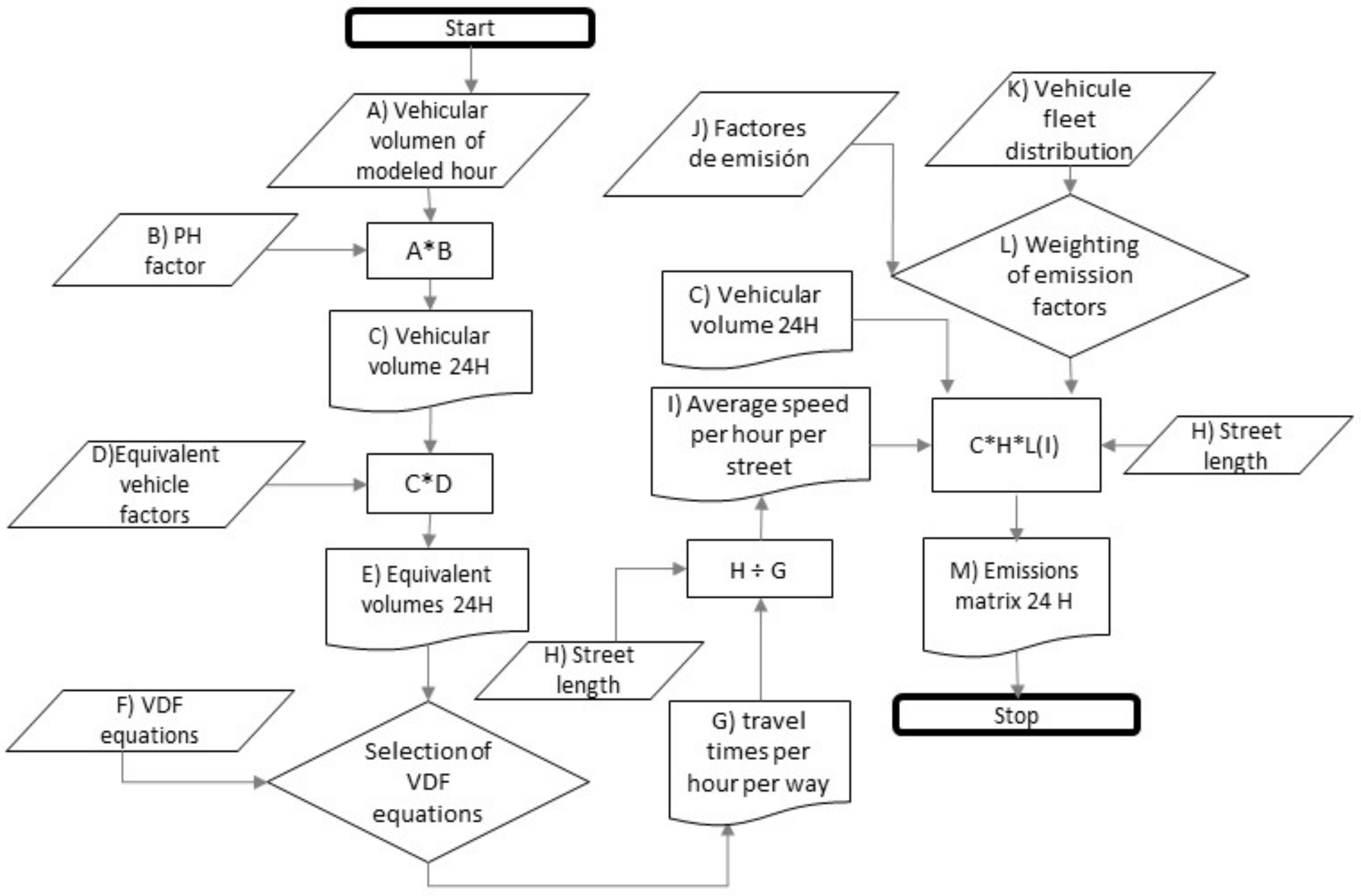
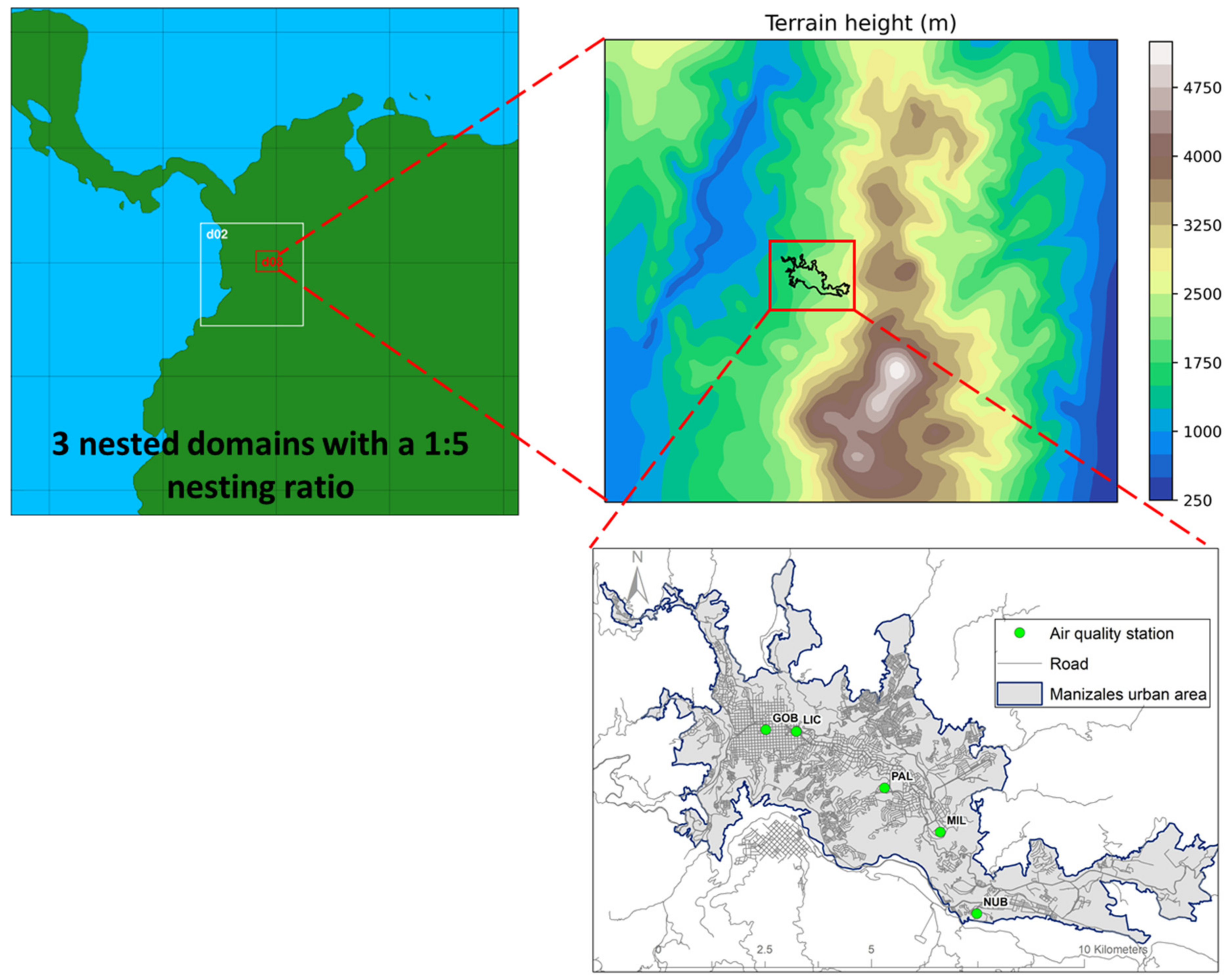
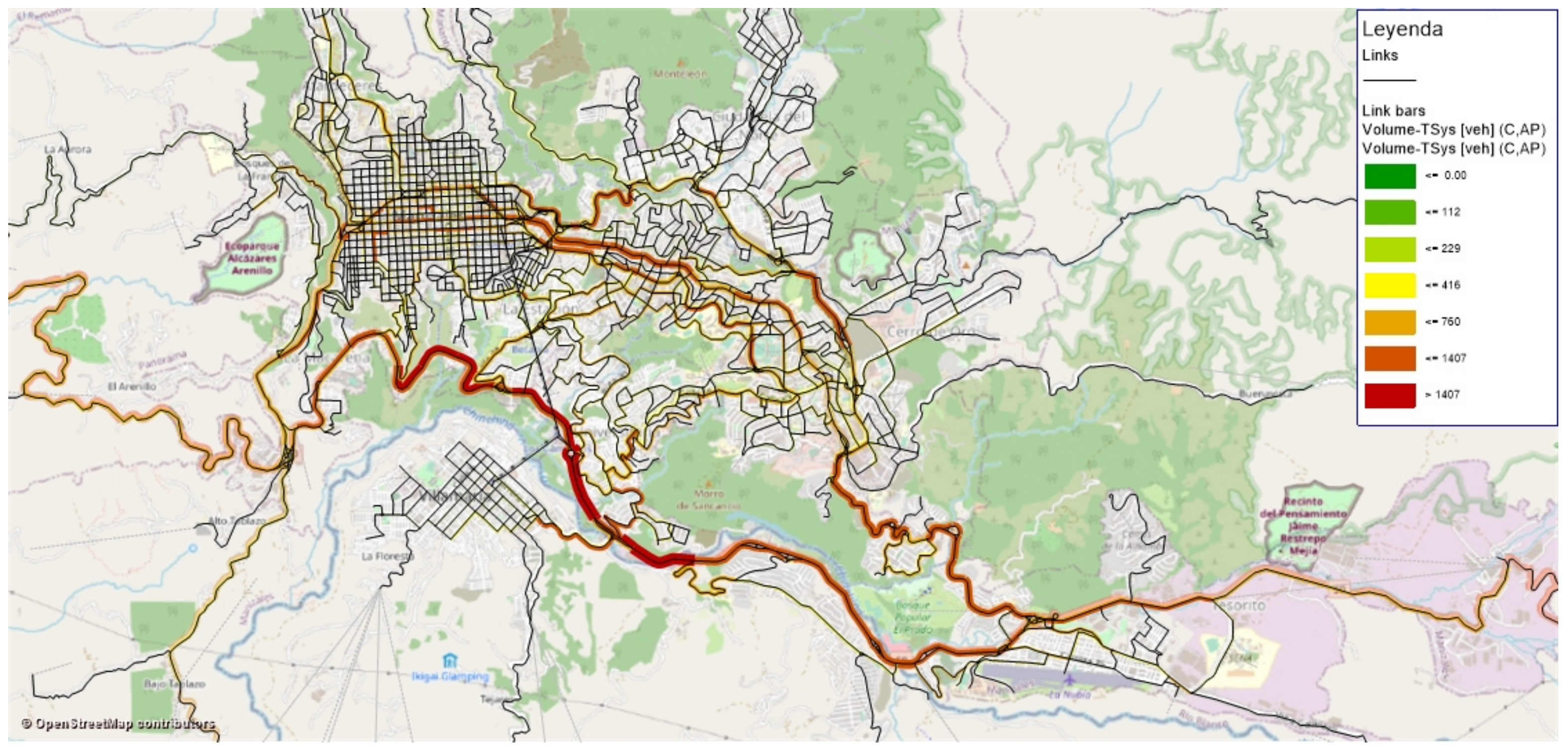

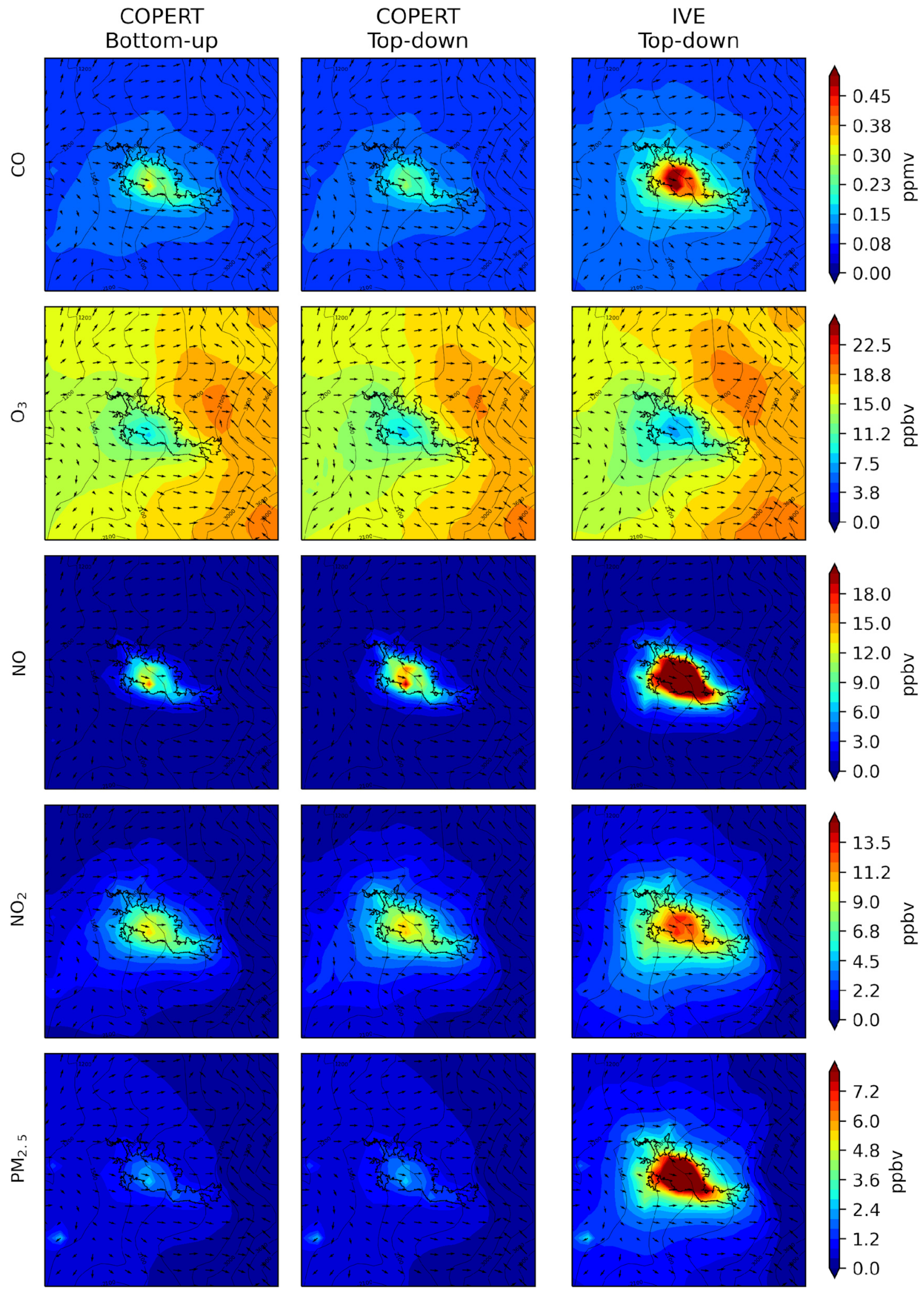
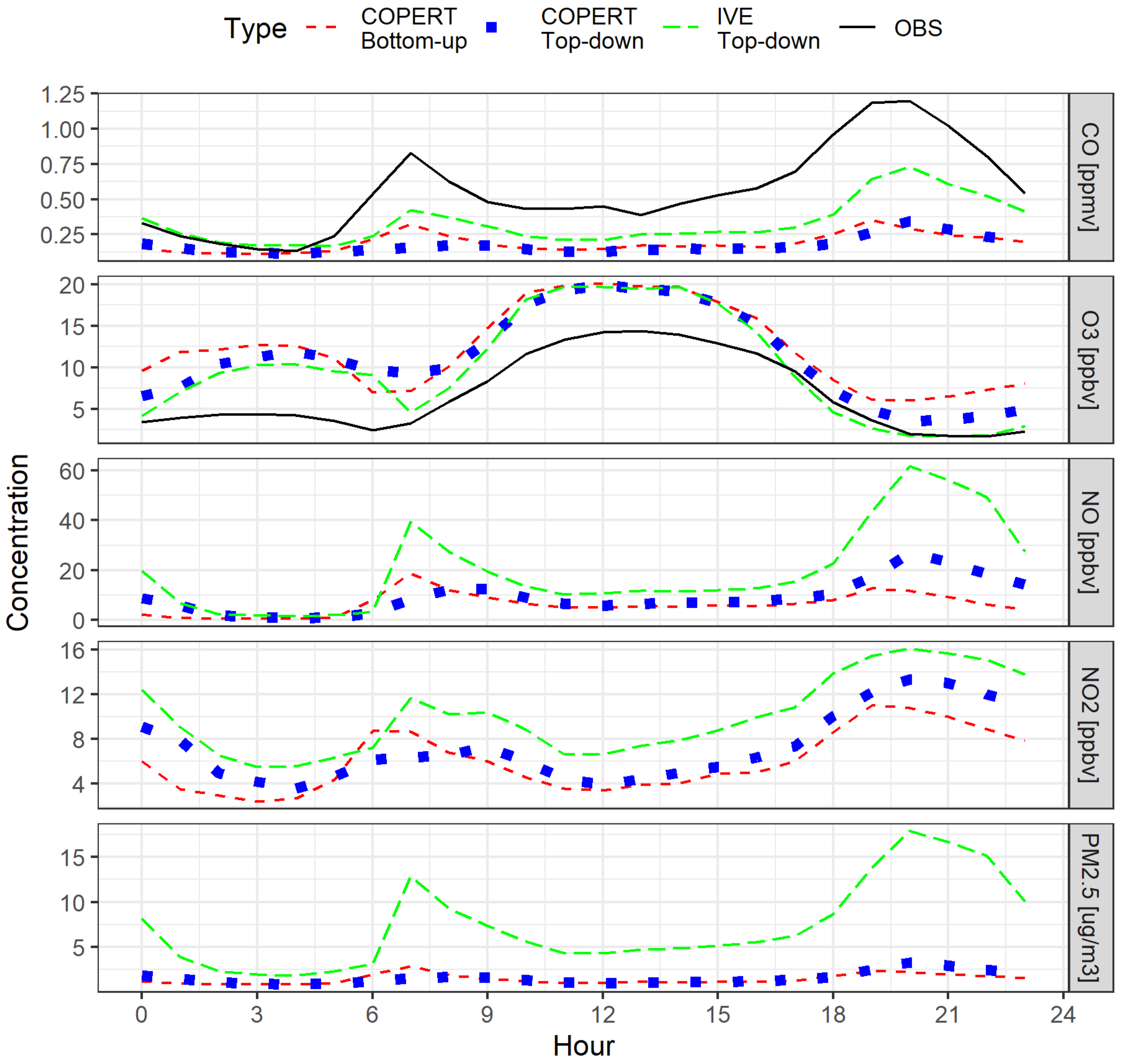
| Parameter | Description |
|---|---|
| Area of study | Manizales and 4 neighbor municipalities |
| Number of traffic analysis zones | 409 |
| Number of modeled nodes | 2322 |
| Number or modeled road links | 6562 |
| Modeling base year | 2017 |
| Modeled time period | 6:45—7:45 |
| Number of vehicle classes * | 8, including private vehicles, taxis, motorcycles, heavy goods vehicles, light goods vehicles, urban buses, cableway, intercity buses. |
| Vehicle Category | Pollutants | ||||||||||
|---|---|---|---|---|---|---|---|---|---|---|---|
| CO | NOx | SO2 | BC | PM2.5 | PM10 | NMVOC | VOC | CO2 | N2O | CH4 | |
| IVE/Top-Down | |||||||||||
| Total emissions (ton/year) | 25,082.8 | 4358.7 | 28.4 | --- | --- | 555.6 | 3835.8 | --- | 517,948.0 | 17.8 | 1650.9 |
| Passenger car | 32.9% | 16.2% | 64.8% | --- | --- | 3.9% | 13.9% | --- | 40.2% | 55.1% | 27.7% |
| Motorcycle | 36.6% | 2.2% | 18.0% | --- | --- | 13.2% | 75.9% | --- | 10.1% | 0.0% | 35.3% |
| Taxi | 24.5% | 7.4% | 11.3% | --- | --- | 1.2% | 2.2% | --- | 15.6% | 24.2% | 36.9% |
| Bus | 2.3% | 38.6% | 3.2% | --- | --- | 42.4% | 3.4% | --- | 17.2% | 6.7% | 0.0% |
| Truck | 3.7% | 35.6% | 3.2% | --- | --- | 39.3% | 4.5% | --- | 16.9% | 14.0% | 0.1% |
| COPERT/Top-Down | |||||||||||
| Total emissions (ton/year) | 11,483.7 | 2518.4 | 20.5 | 40.5 | 88.7 | 88.7 | 2013.5 | 2171.4 | 367,907.7 | 17.2 | 157.9 |
| Passenger car | 28.7% | 18.7% | 56.1% | 6.4% | 5.3% | 5.3% | 23.4% | 23.2% | 32.8% | 75.0% | 19.8% |
| Motorcycle | 65.3% | 6.5% | 24.4% | 11.4% | 36.4% | 36.4% | 71.4% | 70.4% | 12.4% | 7.0% | 57.2% |
| Taxi | 2.9% | 1.5% | 5.9% | 0.5% | 0.6% | 0.6% | 1.6% | 1.9% | 7.3% | 5.2% | 5.4% |
| Bus | 2.5% | 58.4% | 10.7% | 64.9% | 45.7% | 45.7% | 2.6% | 3.5% | 37.3% | 9.9% | 15.0% |
| Truck | 0.7% | 14.8% | 2.9% | 16.5% | 12.2% | 12.2% | 0.9% | 1.1% | 10.2% | 2.9% | 2.6% |
| COPERT/Bottom-Up | |||||||||||
| Total emissions (ton/year) | 16,567.0 | 2424.8 | 25.2 | 38.6 | 109.6 | 131.9 | 3111.8 | 3132.6 | 414,065.4 | 17.3 | 165.7 |
| Passenger car | 33.4% | 20.1% | 55.9% | 8.9% | 12.4% | 16.2% | 25.3% | 25.5% | 36.0% | 73.0% | 17.1% |
| Motorcycle | 59.6% | 7.7% | 26.3% | 13.6% | 35.1% | 31.9% | 67.1% | 69.7% | 15.1% | 7.5% | 58.4% |
| Taxi | 5.2% | 2.8% | 7.8% | 1.4% | 3.2% | 4.6% | 5.7% | 1.9% | 10.2% | 8.2% | 10.3% |
| Bus | 1.2% | 42.7% | 6.0% | 47.9% | 30.2% | 28.8% | 1.1% | 1.8% | 23.3% | 6.7% | 9.9% |
| Truck | 0.7% | 26.7% | 4.0% | 28.2% | 19.0% | 18.5% | 0.9% | 1.1% | 15.4% | 4.6% | 4.3% |
| Vehicle Category | Percent Change | ||||||||||
|---|---|---|---|---|---|---|---|---|---|---|---|
| CO | NOx | SO2 | BC | PM2.5 | PM10 | NMVOC | VOC | CO2 | N2O | CH4 | |
| Passenger car | 67.8% | 3.4% | 22.5% | 31.9% | 189.8% | 354.8% | 66.7% | 58.9% | 24.0% | −2.1% | −9.5% |
| Motorcycle | 31.6% | 13.4% | 32.6% | 13.8% | 19.3% | 30.3% | 45.1% | 42.9% | 36.8% | 8.3% | 7.2% |
| Taxi | 160.8% | 74.0% | 63.1% | 172.0% | 606.2% | 1106.1% | 455.1% | 48.8% | 56.9% | 57.5% | 100.9% |
| Bus | −32.3% | −29.6% | −30.9% | −29.7% | −18.2% | −6.3% | −34.7% | −27.4% | −29.2% | −31.7% | −30.5% |
| Truck | 56.2% | 73.5% | 68.5% | 62.5% | 92.7% | 126.3% | 41.0% | 47.9% | 70.7% | 59.2% | 72.4% |
| Total | 44.3% | −3.7% | 22.9% | −4.7% | 23.6% | 48.7% | 54.5% | 44.3% | 12.9% | 0.6% | 4.9% |
| Vehicle Category | Percentual Change (COPERT—IVE/IVE) | ||||||||||
|---|---|---|---|---|---|---|---|---|---|---|---|
| CO | NOx | SO2 | BC | PM2.5 | PM10 | NMVOC | VOC | CO2 | N2O | CH4 | |
| Passenger car | −60.1% | −33.2% | −37.5% | --- | --- | −78.5% | −11.8% | --- | −42.3% | 31.6% | −93.2% |
| Motorcycle | −18.4% | 75.1% | −2.0% | --- | --- | −55.9% | −50.6% | --- | −12.7% | −84.5% | |
| Taxi | −94.6% | −88.0% | −62.5% | --- | --- | −92.5% | −62.9% | --- | −66.6% | −79.1% | −98.6% |
| Bus | −49.4% | −12.6% | 144.4% | --- | --- | −82.8% | −60.2% | --- | 53.0% | 41.7% | |
| Truck | −91.9% | −75.9% | −33.3% | --- | --- | −95.1% | −88.9% | --- | −57.3% | −80.0% | 310.0% |
| Total | −54.2% | −42.2% | −27.8% | --- | --- | −84.0% | −47.5% | --- | −29.2% | −3.4% | −90.4% |
| Simulation | Statistic * | Variable | |||
|---|---|---|---|---|---|
| O3 [ppbv] | CO [ppmv] | PM10 [µg/m3] | PM2.5 [µg/m3] | ||
| IVE Top-down | Min | 0.00 | 0.09 | 3.43 | 4.37 |
| Max | 32.50 | 1.58 | 12.24 | 7.78 | |
| MB | 3.10 | −0.23 | −12.10 | −6.76 | |
| MGE | 4.62 | 0.30 | 12.10 | 6.93 | |
| RMSE | 5.95 | 0.42 | 12.84 | 8.07 | |
| NMB | 0.46 | −0.41 | −0.62 | −0.51 | |
| NMGE | 0.69 | 0.53 | 0.62 | 0.52 | |
| NRMSE | 1.12 | 1.05 | 2.79 | 1.73 | |
| R | 0.70 | 0.47 | 0.37 | 0.09 | |
| COPERT Top-down | Min | 0.00 | 0.08 | 0.69 | 0.79 |
| Max | 26.74 | 0.74 | 2.65 | 2.32 | |
| MB | 4.39 | −0.39 | −17.76 | −11.89 | |
| MGE | 5.25 | 0.40 | 17.76 | 11.89 | |
| RMSE | 6.49 | 0.54 | 18.34 | 12.68 | |
| NMB | 0.65 | −0.69 | −0.92 | −0.89 | |
| NMGE | 0.78 | 0.71 | 0.92 | 0.89 | |
| NRMSE | 1.22 | 1.35 | 4.08 | 1.65 | |
| R | 0.67 | 0.48 | 0.10 | 0.01 | |
| COPERT Bottom-up | Min | 0.12 | 0.08 | 0.93 | 0.76 |
| Max | 28.46 | 0.82 | 2.53 | 2.19 | |
| MB | 5.52 | −0.37 | −17.81 | −12.01 | |
| MGE | 6.08 | 0.38 | 17.81 | 12.01 | |
| RMSE | 7.18 | 0.52 | 18.37 | 12.77 | |
| NMB | 0.82 | −0.66 | −0.92 | −0.90 | |
| NMGE | 0.90 | 0.68 | 0.92 | 0.90 | |
| NRMSE | 1.35 | 1.30 | 4.09 | 1.66 | |
| R | 0.66 | 0.57 | 0.15 | 0.35 | |
Publisher’s Note: MDPI stays neutral with regard to jurisdictional claims in published maps and institutional affiliations. |
© 2021 by the authors. Licensee MDPI, Basel, Switzerland. This article is an open access article distributed under the terms and conditions of the Creative Commons Attribution (CC BY) license (https://creativecommons.org/licenses/by/4.0/).
Share and Cite
Cifuentes, F.; González, C.M.; Trejos, E.M.; López, L.D.; Sandoval, F.J.; Cuellar, O.A.; Mangones, S.C.; Rojas, N.Y.; Aristizábal, B.H. Comparison of Top-Down and Bottom-Up Road Transport Emissions through High-Resolution Air Quality Modeling in a City of Complex Orography. Atmosphere 2021, 12, 1372. https://doi.org/10.3390/atmos12111372
Cifuentes F, González CM, Trejos EM, López LD, Sandoval FJ, Cuellar OA, Mangones SC, Rojas NY, Aristizábal BH. Comparison of Top-Down and Bottom-Up Road Transport Emissions through High-Resolution Air Quality Modeling in a City of Complex Orography. Atmosphere. 2021; 12(11):1372. https://doi.org/10.3390/atmos12111372
Chicago/Turabian StyleCifuentes, Felipe, Carlos M. González, Erika M. Trejos, Luis D. López, Francisco J. Sandoval, Oscar A. Cuellar, Sonia C. Mangones, Néstor Y. Rojas, and Beatriz H. Aristizábal. 2021. "Comparison of Top-Down and Bottom-Up Road Transport Emissions through High-Resolution Air Quality Modeling in a City of Complex Orography" Atmosphere 12, no. 11: 1372. https://doi.org/10.3390/atmos12111372
APA StyleCifuentes, F., González, C. M., Trejos, E. M., López, L. D., Sandoval, F. J., Cuellar, O. A., Mangones, S. C., Rojas, N. Y., & Aristizábal, B. H. (2021). Comparison of Top-Down and Bottom-Up Road Transport Emissions through High-Resolution Air Quality Modeling in a City of Complex Orography. Atmosphere, 12(11), 1372. https://doi.org/10.3390/atmos12111372







